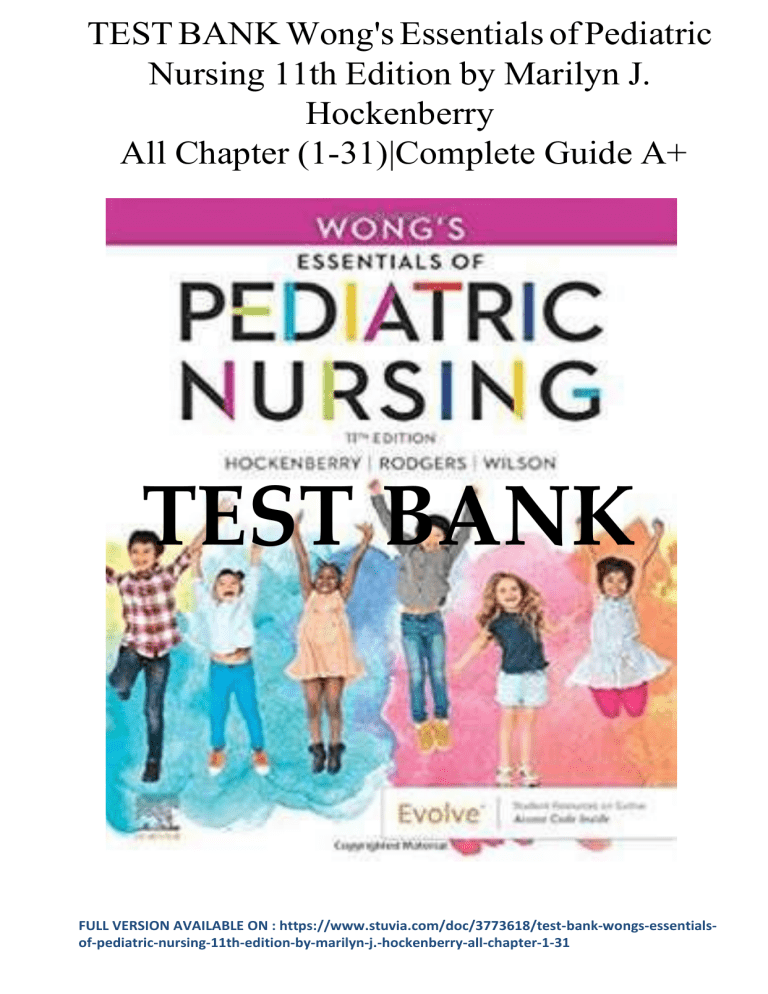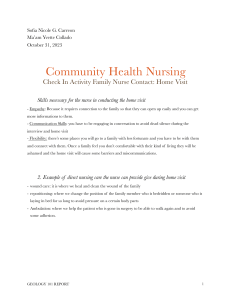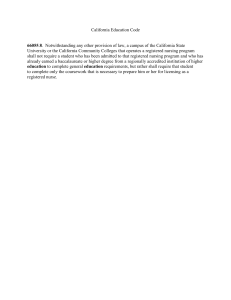TEST BANK Wong's Essentials of Pediatric Nursing 11th Edition by Marilyn J. Hockenberry
advertisement

TEST BANK Wong's Essentials of Pediatric Nursing 11th Edition by Marilyn J. Hockenberry All Chapter (1-31)|Complete Guide A+ TEST BANK FULL VERSION AVAILABLE ON : https://www.stuvia.com/doc/3773618/test-bank-wongs-essentialsof-pediatric-nursing-11th-edition-by-marilyn-j.-hockenberry-all-chapter-1-31 Table of Content Chapter 01: Children, Their Families, and the Nurse Chapter 02: Social, Cultural, Religious, and Family Influences on Child Health Promotion Chapter 03: Developmental and Genetic Influences on Child Health Promotion Chapter 04: Communication and Physical Assessment of the Child and Family Chapter 05: Pain Assessment and Management in Children Chapter 06: Childhood Communicable and Infectious Diseases Chapter 07: Health Promotion of the Newborn and Family Chapter 08: Health Problems of Newborns Chapter 09: Health Promotion of the Infant and Family Chapter 10: Health Problems of Infants Chapter 11: Health Promotion of the Toddler and Family Chapter 12: Health Promotion of the Preschooler and Family Chapter 13: Health Problems of Toddlers and Preschoolers Chapter 14: Health Promotion of the School-Age Child and Family Chapter 15: Health Promotion of the Adolescent and Family Chapter 16: Health Problems of School-Age Children and Adolescents Chapter 17: Impact of Chronic Illness, Disability, or End-of-Life Care on the Child and Family Chapter 18: Impact of Cognitive or Sensory Impairment on the Child and Family Chapter 19: Family-Centered Care of the Child During Illness and Hospitalization Chapter 20: Pediatric Nursing Interventions and Skills Chapter 21: The Child With Respiratory Dysfunction Chapter 22: The Child With Gastrointestinal Dysfunction Chapter 23: The Child With Cardiovascular Dysfunction Chapter 24: The Child With Hematologic or Immunologic Dysfunction Chapter 25: The Child With Cancer Chapter 26: The Child With Genitourinary Dysfunction Chapter 27: The Child With Cerebral Dysfunction Chapter 28: The Child With Endocrine Dysfunction Chapter 29: The Child With Musculoskeletal or Articular Dysfunction Chapter 30: The Child With Neuromuscular or Muscular Dysfunction Chapter 31: The Child With Integumentary Dysfunction Chapter 01: Children, Their Families, and the Nurse Evolve Resources for Wong’s Essentials of Pediatric Nursing, 11th Edition MULTIPLE CHOICE 1. The nurse would include which associated risk when planning a teaching session about childhood obesity? a. Type I diabetes b. Respiratory disease c. Celiac disease d. Type II diabetes ANS: D FULL VERSION AVAILABLE ON : https://www.stuvia.com/doc/3773618/test-bank-wongs-essentials-ofpediatric-nursing-11th-edition-by-marilyn-j.-hockenberry-all-chapter-1-31 Childhood obesity has been associated with the rise of type II diabetes in children. Type I diabetes is not associated with obesity and has a genetic component. Respiratory disease is not associated with obesity, and celiac disease is the inability to metabolize gluten in foods and is not associated with obesity. DIF: Cognitive Level: Remember TOP: Integrated Process: Nursing Process: Planning MSC: Area of Client Needs: Health Promotion and Maintenance 2. Which second-leading cause of death topic would the nurse emphasize to a group of boys ranging in age from 15 to 19 years? a. Suicide b. Cancer c. Homicide d. Occupational injuries ANS: C Firearm homicide is the second overall cause of death in this age group and the leading cause of death in African-American males. Suicide is the third-leading cause of death in this population. Cancer, although a major health problem, is the fourth-leading cause of death in this age group. Occupational injuries do not contribute to a significant death rate for this age group. DIF: Cognitive Level: Understand TOP: Integrated Process: Nursing Process: Planning MSC: Area of Client Needs: Health Promotion and Maintenance 3. Which is the major cause of death for children older than 1 year? a. Cancer b. Heart disease c. Unintentional injuries d. Congenital anomalies ANS: C Unintentional injuries (accidents) are the leading cause of death after age 1 year through adolescence. Congenital anomalies are the leading cause of death in those younger than 1 year. Cancer ranks either second or fourth, depending on the age group, and heart disease ranks fifth in the majority of the age groups. DIF: Cognitive Level: Remember TOP: Integrated Process: Nursing Process: Planning MSC: Area of Client Needs: Health Promotion and Maintenance 4. Which factor most impacts the type of injury a child is susceptible to, according to the child’s age? a. Physical health of the child b. Developmental level of the child c. Educational level of the child d. Number of responsible adults in the home FULL VERSION AVAILABLE ON : https://www.stuvia.com/doc/3773618/test-bank-wongsessentials-of-pediatric-nursing-11th-edition-by-marilyn-j.-hockenberry-all-chapter-1-31 ANS: B The child’s developmental stage determines the type of injury that is likely to occur. The child’s physical health may facilitate the child’s recovery from an injury but does not impact the type of injury. Educational level is related to developmental level, but it is not as important as the child’s developmental level in determining the type of injury. The number of responsible adults in the home may affect the number of unintentional injuries, but the type of injury is related to the child’s developmental stage. DIF: Cognitive Level: Understand TOP: Integrated Process: Nursing Process: Planning MSC: Area of Client Needs: Health Promotion and Maintenance 5. A nurse on a pediatric unit is practicing family-centered care. Which is most descriptive of the care the nurse is delivering? a. Taking over total care of the child to reduce stress on the family b. Encouraging family dependence on health care systems c. Recognizing that the family is the constant in a child’s life d. Excluding families from the decision-making process ANS: C The three key components of family-centered care are respect, collaboration, and support. Family-centered care recognizes the family as the constant in the child’s life. Taking over total care does not include the family in the process and may increase stress instead of reducing stress. The family should be enabled and empowered to work with the health care system. The family is expected to be part of the decision-making process. DIF: Cognitive Level: Understand TOP: Integrated Process: Nursing Process: Implementation MSC: Area of Client Needs: Health Promotion and Maintenance 6. Which intervention would the nurse include when providing atraumatic care? a. Prepare the child for separation from parents during hospitalization by reviewing a video. b. Prepare the child before any unfamiliar treatment or procedure. c. Help the child accept the loss of control associated with hospitalization. d. Help the child accept pain that is connected with a treatment or procedure. ANS: B Preparing the child for any unfamiliar treatments, controlling pain, allowing privacy, providing play activities for expression of fear and aggression, providing choices, and respecting cultural differences are components of atraumatic care. In the provision of atraumatic care, the separation of child from parents during hospitalization is minimized. The nurse should promote a sense of control for the child. Preventing and minimizing bodily injury and pain are major components of atraumatic care. FULL VERSION AVAILABLE ON : https://www.stuvia.com/doc/3773618/test-bank-wongsessentials-of-pediatric-nursing-11th-edition-by-marilyn-j.-hockenberry-all-chapter-1-31 DIF: Cognitive Level: Understand TOP: Integrated Process: Nursing Process: Implementation MSC: Area of Client Needs: Psychosocial Integrity 7. Which is suggestive that a nurse has a nontherapeutic relationship with a patient and family? a. Staff is concerned about the nurse’s closeness with the patient and family. b. Staff assignments allow the nurse to care for same patient and family over an extended time. c. Nurse is able to withdraw emotionally when emotional overload occurs but still remains committed. d. Nurse uses teaching skills to instruct patient and family rather than doing everything for them. ANS: A A clue to a nontherapeutic staff-patient relationship is concern by other staff members. Allowing the nurse to care for the same patient over time would be therapeutic for the patient and family. Nurses who are able to somewhat withdraw emotionally can protect themselves while providing therapeutic care. Nurses using teaching skills to instruct patient and family will assist in transitioning the child and family to self-care. DIF: Cognitive Level: Analyze TOP: Integrated Process: Nursing Process: Assessment MSC: Area of Client Needs: Psychosocial Integrity 8. Which is descriptive of clinical reasoning? a. A simple developmental process b. A cognitive process used to analyze data c. Based on deliberate and irrational thought d. Assists individuals in guessing which is most appropriate ANS: B Clinical reasoning is a complex, developmental process based on rational and deliberate thought. Clinical reasoning is not a developmental process. Clinical reasoning is based on rational and deliberate thought. Clinical reasoning is not a guessing process. DIF: Cognitive Level: Understand TOP: Integrated Process: Nursing Process: Planning MSC: Area of Client Needs: Safe and Effective Care Environment: Management of Care 9. A nurse makes the decision to apply a topical anesthetic to a child’s skin before drawing blood. Which ethical principle is the nurse demonstrating? a. Autonomy b. Beneficence c. Justice d. Truthfulness FULL VERSION AVAILABLE ON : https://www.stuvia.com/doc/3773618/test-bank-wongsessentials-of-pediatric-nursing-11th-edition-by-marilyn-j.-hockenberry-all-chapter-1-31 ANS: B Beneficence is the obligation to promote the patient’s well-being. Applying a topical anesthetic before drawing blood promotes reducing the discomfort of the venipuncture. Autonomy is the patient’s right to be self-governing. Justice is the concept of fairness. Truthfulness is the concept of honesty. DIF: Cognitive Level: Understand TOP: Integrated Process: Nursing Process: Implementation MSC: Area of Client Needs: Physiological Integrity 10. Which action by the nurse demonstrates use of evidence-based practice (EBP)? a. Gathering equipment for a procedure b. Documenting changes in a patient’s status c. Questioning the practice of daily central line dressing changes d. Clarifying a physician’s prescription for morphine ANS: C The nurse who questions the daily central line dressing change is ascertaining whether clinical interventions result in positive outcomes for patients. This demonstrates EBP, which implies questioning why something is effective and whether a better approach exists. Gathering equipment for a procedure and documenting changes in a patient’s status are practices that follow established guidelines. Clarifying a physician’s prescription for morphine constitutes safe nursing care. DIF: Cognitive Level: Apply TOP: Integrated Process: Nursing Process: Evaluation MSC: Area of Client Needs: Safe and Effective Care Environment: Management of Care 11. A nurse is admitting a toddler to the hospital and the parents state they will need to leave for a brief period. Which type of nursing diagnosis would the nurse formulate for this child? a. Risk for anxiety b. Anxiety c. Readiness for enhanced coping d. Ineffective coping ANS: A A potential problem is categorized as a risk. The toddler has a risk to become anxious when the parents leave. Nursing interventions will be geared toward reducing the risk. The child is not showing current anxiety or ineffective coping. The child is not at a point for readiness for enhanced coping, especially because the parents will be leaving. DIF: Cognitive Level: Apply TOP: Integrated Process: Nursing Process: Diagnosis MSC: Area of Client Needs: Health Promotion and Maintenance FULL VERSION AVAILABLE ON : https://www.stuvia.com/doc/3773618/test-bank-wongs-essentialsof-pediatric-nursing-11th-edition-by-marilyn-j.-hockenberry-all-chapter-1-31 12. Which depicts accurate documentation for a dressing change on a child who has an appendectomy incision? a. Dressing change to appendectomy incision completed, child tolerated procedure well, parent present b. No complications noted during dressing change to appendectomy incision c. Appendectomy incision non-reddened, sutures intact, no drainage noted on old dressing, new dressing applied, procedure tolerated well by child d. No changes to appendectomy incisional area, dressing changed, child complained of pain during procedure, new dressing clean, dry and intact ANS: C The nurse should document assessments and reassessments. Appearance of the incision described in objective terms should be included during a dressing change. The nurse should document patient’s response and the outcomes of the care provided. In this example, these include drainage on the old dressing, the application of the new dressing, and the child’s response. The other statements partially fulfill the requirements of documenting assessments and reassessments, patient’s response, and outcome, but do not include all three. DIF: Cognitive Level: Analyze TOP: Integrated Process: Nursing Process: Implementation MSC: Area of Client Needs: Safe and Effective Care Environment: Management of Care 13. A nurse is planning a class on accident prevention for parents of toddlers. Which safety topic is the priority for this class? a. Correct use of car seat restraints b. Safety crossing the street c. Helmet use when riding a bicycle d. Poison control numbers ANS: A Motor vehicle accidents (MVAs) continue to be the most common cause of death in children older than 1 year, therefore the priority topic is appropriate use of car seat restraints. Safety crossing the street and bicycle helmet use are topics that should be included for preschool parents but are not priorities for parents of toddlers. Information about poison control is important for parents of toddlers and would be a safety topic to include but is not the priority over appropriate use of car seat restraints. DIF: Cognitive Level: Apply TOP: Integrated Process: Nursing Process: Planning MSC: Area of Client Needs: Health Promotion and Maintenance FULL VERSION AVAILABLE ON : https://www.stuvia.com/doc/3773618/test-bank-wongs-essentialsof-pediatric-nursing-11th-edition-by-marilyn-j.-hockenberry-all-chapter-1-31 14. A nurse is collecting subjective and objective information about target populations to diagnose problems based on community needs. This describes which step in the community nursing process? a. Planning b. Diagnosis c. Assessment d. Establishing objectives ANS: C Assessment is a continuous process that operates at all phases of problem solving and is the foundation for decision making. Assessment involves multiple nursing skills and consists of the purposeful collection, classification, and analysis of data from a variety of sources. Diagnosing is the next step of the nursing process when the problem is identified. The nurse should establish objectives for the activity before starting the nursing process. DIF: Cognitive Level: Remember TOP: Integrated Process: Nursing Process: Assessment MSC: Area of Client Needs: Safe and Effective Care Environment: Management of Care 15. A nurse has established several health programs, such as bicycle safety, to improve the health status of a target population. This describes which step in the community nursing process? a. Planning b. Evaluation c. Assessment d. Implementation ANS: D FULL VERSION AVAILABLE ON : https://www.stuvia.com/doc/3773618/test-bank-wongs-essentialsof-pediatric-nursing-11th-edition-by-marilyn-j.-hockenberry-all-chapter-1-31 The nurse working with the community to put into practice a program to reach community goals is the implementation phase of the community nursing process. Planning involves designing the program to meet community-centered goals. The evaluation stage would determine the effectiveness of the program. During the assessment phase, the nurse would identify the resources necessary and the barriers that would interfere with implementation. DIF: Cognitive Level: Apply TOP: Integrated Process: Nursing Process: Implementation MSC: Area of Client Needs: Safe and Effective Care Environment: Management of Care 16. When communicating with other professionals, which is important for the nurse to do? a. Ask others what they want to know. b. Share everything known about the family. c. Restrict communication to clinically relevant information. d. Recognize that confidentiality is not possible. ANS: C The nurse will need to share, through both oral and written communication, clinically relevant information with other involved health professionals. Asking others what they want to know and sharing everything known about the family is inappropriate. Patients have a right to confidentiality. The nurse is not permitted to share information about clients, except clinically relevant information that pertains to the child’s care. Confidentiality permits the disclosure of information to other health professionals on a need-to-know basis. DIF: Cognitive Level: Apply TOP: Integrated Process: Communication and Documentation MSC: Area of Client Needs: Safe and Effective Care Environment: Management of Care 17. A nurse is formulating a clinical question for evidence-based practice. Place in sequential order the steps the nurse should use to clarify the scope of the problem and clinical topic of interest: FULL VERSION AVAILABLE ON : https://www.stuvia.com/doc/3773618/test-bank-wongsessentials-of-pediatric-nursing-11th-edition-by-marilyn-j.-hockenberry-all-chapter-1-31 1. Intervention 2. Outcome 3. Population 4. Time 5. Comparison a. 4, 5, 1, 2, 1 b. 5, 2, 3, 4, 1 c. 3, 1, 5, 2, 4 d. 2, 3, 1, 5, 4 ANS: C When formulating a clinical question for evidence-based practice, the nurse would follow a concise, organized way that allows for clear answers. Good clinical questions should be asked in the PICOT (population, intervention, comparison, outcome, time) format to assist with clarity and literature searching. PICOT questions assist with clarifying the scope of the problem and clinical topic of interest. DIF: Cognitive Level: Understand TOP: Integrated Process: Nursing Process: Assessment MSC: Area of Client Needs: Health Promotion and Maintenance MULTIPLE RESPONSE 1. The following account for nearly half of all deaths in infants younger than 1 year? (Select all that apply.) a. Congenital anomalies b. Sudden infant death syndrome c. Respiratory distress syndrome d. Bacterial sepsis of the newborn e. Disorders relating to short gestation FULL VERSION AVAILABLE ON : https://www.stuvia.com/doc/3773618/test-bank-wongs-essentialsof-pediatric-nursing-11th-edition-by-marilyn-j.-hockenberry-all-chapter-1-31





